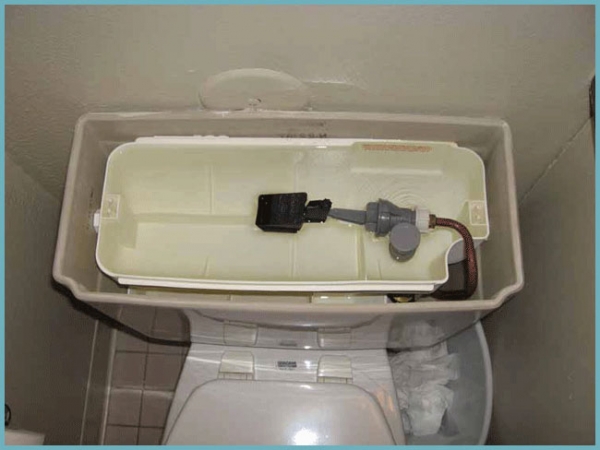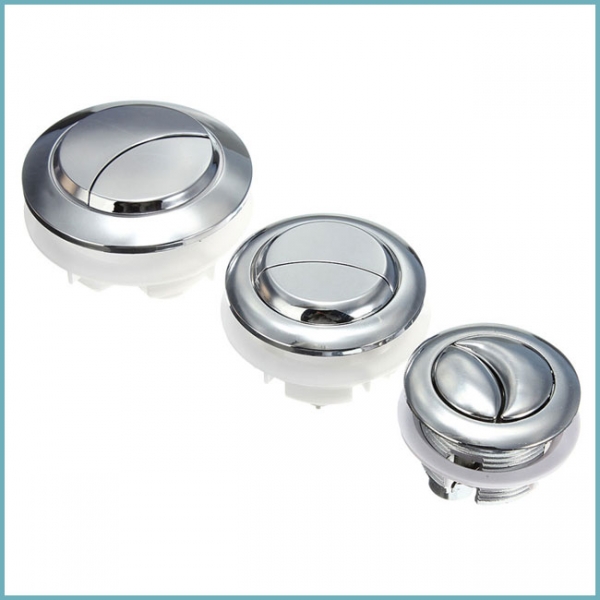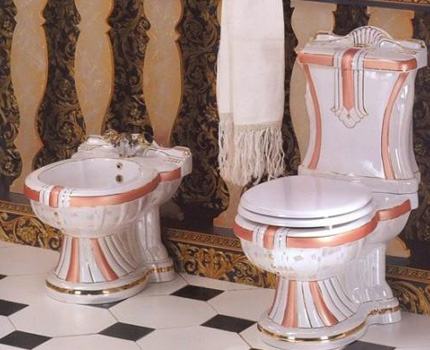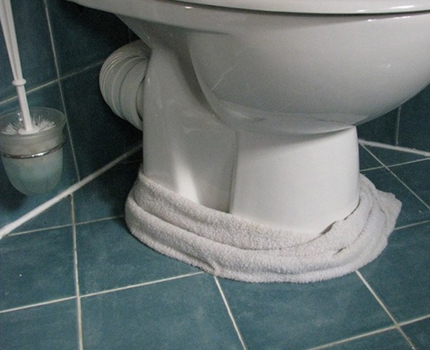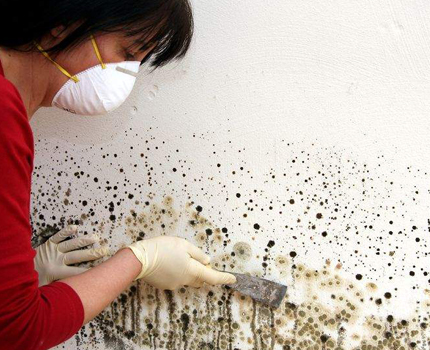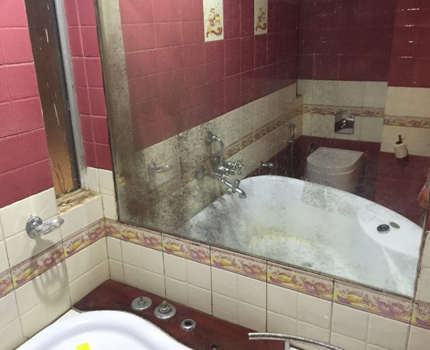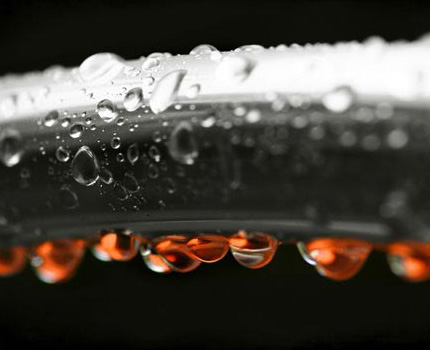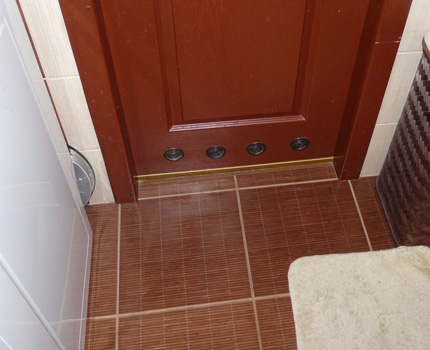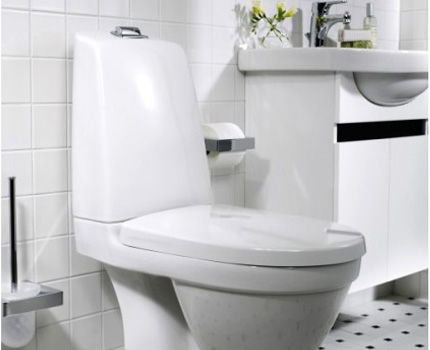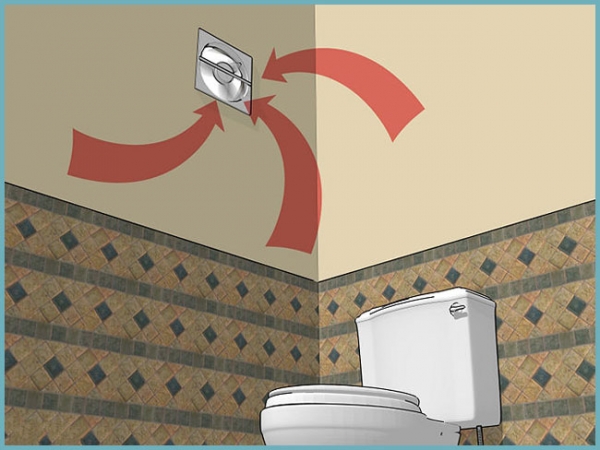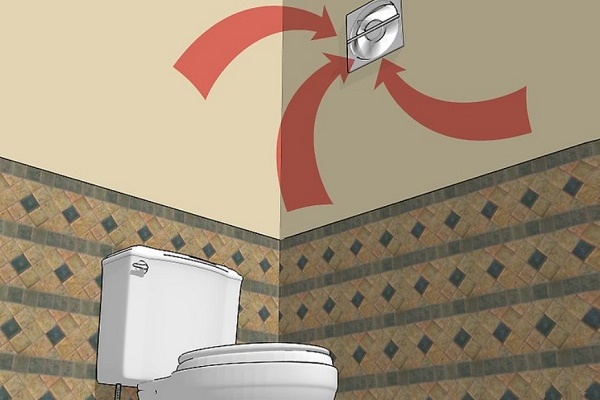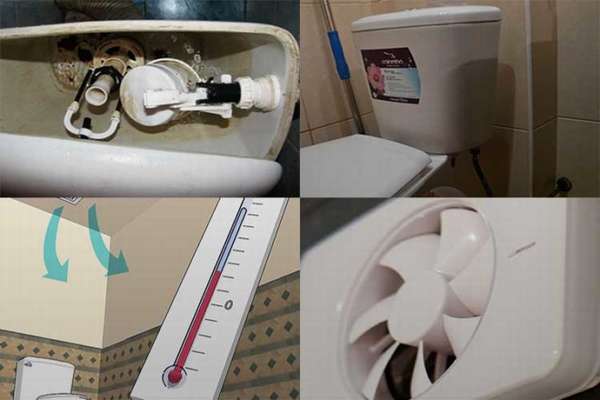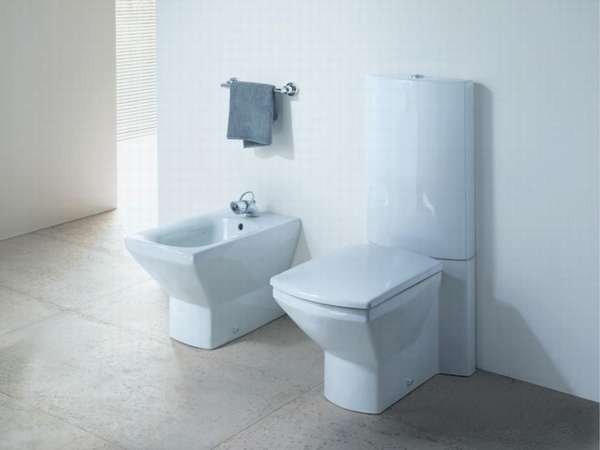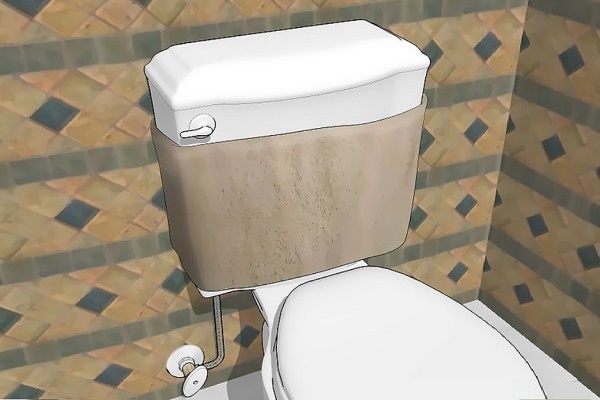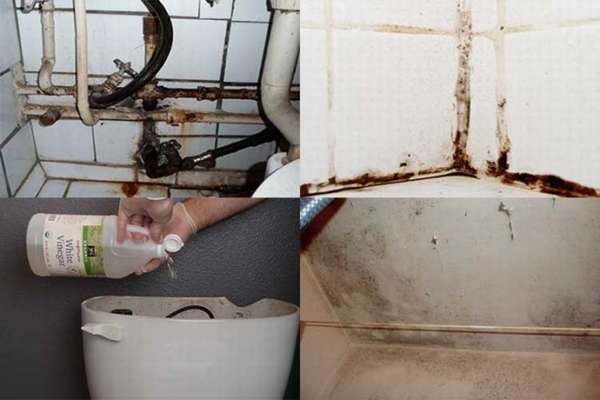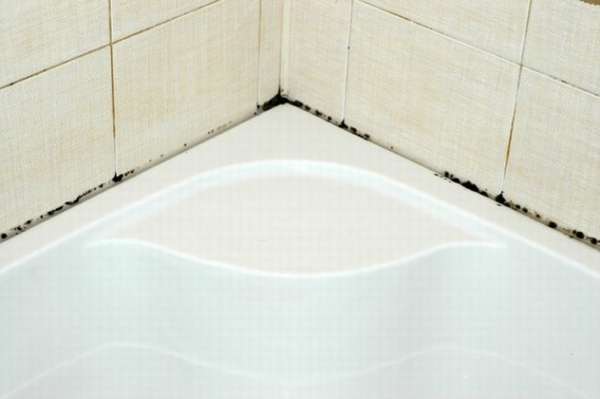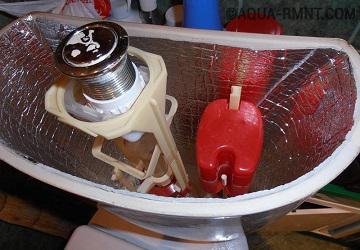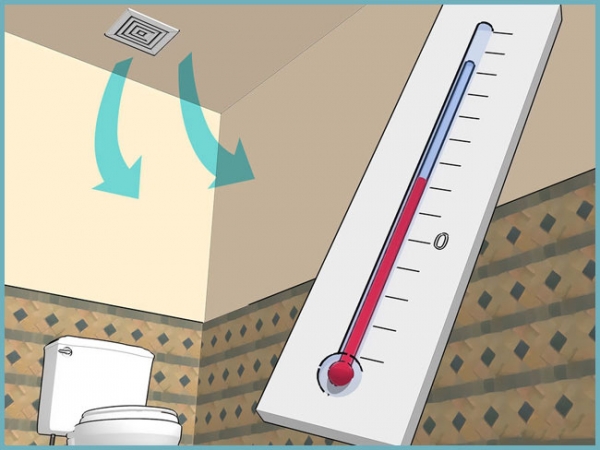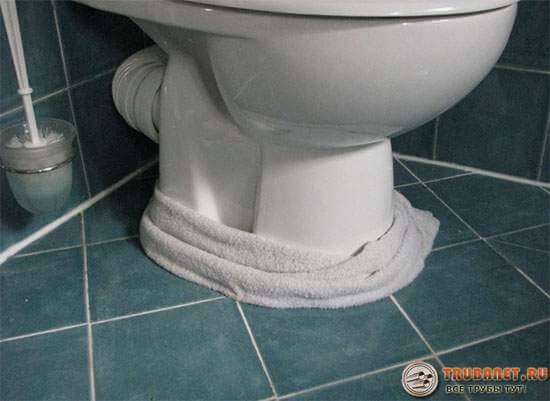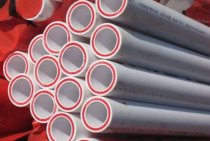Toilet bowl malfunctions and their elimination
If even a thin stream of water flows into the toilet unhindered, then its volume in the tank must be continuously replenished. Hence the water droplets on the surface and high water bills. The solution to the problem is to fix the leak. Sometimes it helps to replace the worn-out rubber membrane of the siphon, for which:
- water is completely drained from the tank;
- fix the lever in such a position that the hole is closed by a valve and no more water flows;
- dismantle the siphon by disconnecting it from the lever;
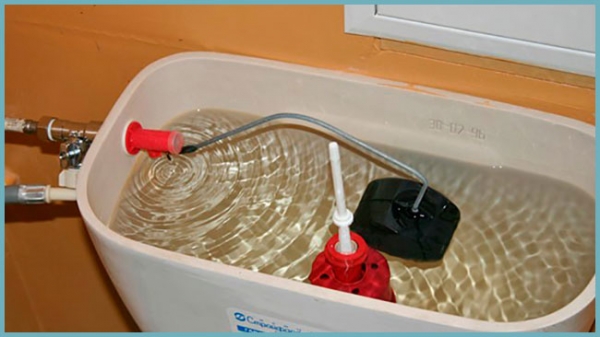
- the worn out membrane is removed and replaced with a new one;
- return the siphon to its place and fix it;
- perform a test run.
The reason may be hiding in a faulty float, then perform the following actions:
- remove the float from the tank;
- pour water out of it;
- let dry;
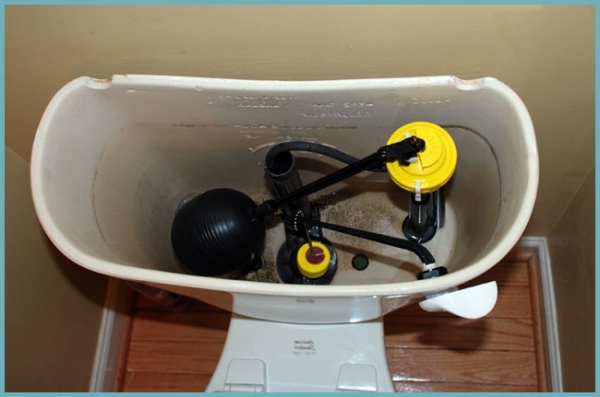
- seal the hole through which water enters it;
- set in place.
If it is possible to buy a new float, then this option is better, because. the repaired part will still not last long. The problem can be solved even easier if the leak occurs due to the incorrect position of the float, in order to eliminate it, it is enough to open the tank and return the lever to its normal position.
Other Ways to Eliminate Condensation
Never sweaty toilet
Not so long ago, models of toilet bowls with a two-piece tank appeared on sale. The water in it is in an internal plastic tank and does not come into contact with the walls of the main vessel, therefore, condensate does not form. The solution is ideal, but the cost is confusing - it is several times higher than that of a toilet bowl with a traditional cistern.
The device of a two-piece toilet bowl
Drain minimization
The less water goes into the sewer, the greater the chance that there will be no condensate. There are toilet bowls with a tank equipped with a two-button mechanism. When one button is used, approximately 5 liters of water flows out of the tank, the other about 7 liters. And in tanks with an aquastop drain system, one control button is mounted in the lid: with one press, the water begins to pour out, and with the second press, this process can be stopped.
Two-button mechanism for descent of water
Drain tank insulation
Some craftsmen independently isolate the walls of the tank from interaction with cold water. The refinement is as follows:
- Turn off the water supply.
- Disconnect the hose through which water enters.
- Take off the sump.
- Dismantle everything inside the tank.
- Rinse the container, wipe dry.
- Cut out the liner from the insulation. To do this, it is laid out on a flat plane, the tank is placed on it in the same position as it usually stands in the working position, the bottom is circled around the perimeter, and then the workpiece is cut out.
- Put the workpiece inside, press firmly.
- The height of the walls is measured from the inside, starting from the liner and ending with the upper edge of the tank. Subtract from the resulting size about 3 cm.
- The perimeter of the walls is also measured from the inside, an allowance of about 100 mm is added.
- Put the pattern inside. The joint is overlapped, therefore, gently pressing the workpiece against the walls, a through cut is made in this place. Take out the blanks.
- Perform assembly:
- apply sealant to the bottom, around the holes for installing fittings;
- set the bottom in place;
- insert the inner liner, having previously applied glue to the sidewalls;
- fill the vertical joint with silicone;
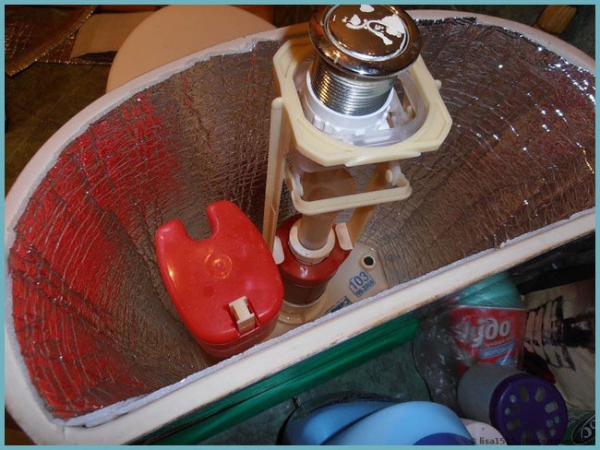
- treat the joint between the bottom and the side walls with a sealant;
- give time to dry for at least a day, cut holes for reinforcement, apply sealant to the edges;
- set everything in place.
Here are the main causes of fogging of the toilet cistern and how to eliminate them. If you cannot remove the condensate yourself, contact a professional.
Forced ventilation
In the case when all the necessary actions with the tank have been carried out, and the presence of moisture on it is still visible, it is worth thinking about forced ventilation of the room. Ventilation problems can be solved in the following ways:
-
- Forced ventilation, one of the effective methods, which is suitable even when moisture collects not only on the tank itself, but also on all surfaces of the bathroom. Such a solution to the problem consists in acquiring a special fan, which is installed in the circulation hole.
To supplement air circulation, you can install a grate on interior doors. So moist air will quickly mix with the rest. It is better to entrust installation work to professionals who will correctly calculate the required (specifically for this room) ventilation level. Before starting work, you need to make sure that the ventilation ducts are clean and have good draft.
Often there are situations when the previous tenants of the apartment close the ventilation hole with some material, and the new guests simply do not pay attention to it.
- With a slight manifestation of condensate, you can simply leave the doors to the bathroom ajar, or in their lower part, make a strip of space so that they do not sit tightly in the door frame.
- A dehumidifier also helps in the fight against condensate. This is an electrical device in which a fan is mounted. Thanks to him, flows of moist air penetrate into the cooling chamber, where the liquid is separated and collected in a container, and the already dried air is returned to the room.
Condensation cannot be removed
It is the owner of the bathroom who will have to decide where exactly to put the comma in this sentence. It all depends on the specific situation and the attitude of all household members to it.
First option. The toilet cistern fogs up a little, but, in between visits to the bathroom / toilet, everything has time to dry out. Here you can do without radical methods to solve the issue of removing condensate.
Slight fogging of surfaces is unable to lead to irreparable consequences and somehow seriously damage the exterior finish of the room.
Second option. If the drain tank is constantly wet, trickles of condensate now and then flow down to the floor and nothing has time to dry. Here the solution is unequivocal - it is necessary to fix the problem.
Drops flowing down the outer surface of the faience container form puddles that need to be wiped off every now and then. Sometimes the situation is quite deplorable - in a day a whole lake is formed in the bathroom. This not only causes inconvenience when visiting the premises, but also greatly unnerves.
Depending on the amount of escaping condensate, prudent owners use methods to eliminate this problem. Some put a towel, while others substitute all kinds of jars and saucers
Constant precipitation of condensate on the drain tank is not only a nuisance at the current time, but also threatens with even greater problems in the coming years.
First, drops of condensate can remain in small crevices and in areas that are difficult to reach. Over time, the water will stagnate and begin to smell unpleasant.
Secondly, constant condensation increases the level of humidity in the bathroom. Especially if it's combined. This situation will certainly provoke the growth and active reproduction of mold and fungus.
Mold spoils the appearance of any room. It adversely affects the body of people who constantly use the bathroom, provoking allergic reactions, headaches and other health problems.
Thirdly, the outer surface of the drain tank, being under the constant influence of water drops, will not last long - in the next 2-3 years a network of small cracks will appear, in which mold and fungus will also begin to form.
Fourthly, due to high humidity, all wooden interior items in the toilet room or combined bathroom will begin to rot. Especially if it is a wooden floor, solid oak / beech parquet or other wood species.
Fifth, the metal parts of furniture, water pipes and other items will begin to suffer from corrosion. Even a mirror can suffer - a whole colony of black mold will grow on its inside.
The mold that has settled on the mirror makes it impossible to use it further. You will need to buy a new one, and this is an additional expense item
As a result, the constant appearance of condensate will result not only in the deterioration of the microclimate in the bathroom, but also in the loss of working condition and loss of appearance in many interior items. After 5-6 years, a major overhaul of a combined bathroom or toilet may be required.
Why does condensation appear on the tank
The condensate that appears on the tank belongs to the category of household problems. To learn how to deal with it effectively, you have to figure out the reasons for its appearance in a particular room.
Only then will it be possible to choose the best option to deal with it.
The nature of the formation of condensate
First of all, you need to understand the nature of the occurrence of "precipitations" on the drain tank. Condensation is water droplets that fall out of the air. They are formed from a sharp temperature drop and act on the surface of objects.
Condensation after taking a shower is a fairly common phenomenon that disappears in a matter of minutes. But the constant streams flowing from the toilet bowl and through the cold water pipes can bring a lot of problems.
The condensate on the drain tank is water formed from the impact of cold water at a temperature of 7-15 ° C on the inner walls of a faience container and warm air at a temperature of 25-32 ° C acting from the outside.
From a sharp drop on the outer walls of the container, like dew, drops of water protrude
Causes of condensation on the tank
The appearance of condensate on the drain tank indicates the presence of one of the problems that must be identified and measures taken to eliminate it.
To understand who is to blame, you have to pay attention to the following factors:
- cold water consumption;
- ventilation in the bathroom;
- condition of the tank fittings;
- humidity level.
With frequent filling of the drain tank, a large amount of condensate forms - cold water does not have time to warm up to room temperature.
Condensation can also be a symptom of a second problem - a non-working ventilation system. Especially if the ventilation hole is removed in the room with the toilet, there is a threshold at the entrance, and the doors fit snugly.
This is quite dangerous for users of combined bathrooms - without proper ventilation, you can simply suffocate.
No matter how beautiful the interior of the combined bathroom is, you have to think about safety first of all by making ventilation holes
Another reason for a drain tank to get wet is a broken shutoff valve. When the seals leak or the float is out of order, the increased water consumption and, as a result, the excessive appearance of condensate on the outer wall of the faience tank cannot be avoided.
Even the most expensive monolithic drain tank is not immune from the breakdown of the internal filling, when you can see puddles of condensate on the floor, which simply should not be there
An increased level of humidity in the bathroom may be due to the circulation of excessively humid air entering this room from other rooms in the house/apartment.
Or due to the fact that the owner of a small apartment constantly dries clothes in the bathroom combined with a toilet. The same problem is observed if wet linen hangs in the kitchen, bordering the bathroom.
Whatever the reason causing the formation of condensate on the drain tank, it must be clearly identified and only then proceed to elimination. After a successful solution of the identified problem, the condensate will also go away.
Faulty ventilation as a cause of condensation
A poorly functioning ventilation system can also cause the cistern to sweat. But many apartment owners, trying to improve the appearance of the room, simply cover the ventilation openings with cladding. This should not be done, it is better to purchase beautiful decorative grilles, specially designed for this.
To check if the ventilation in the bathroom is working well, you must do the following:
- Light a lighter or match and bring it to the ventilation hole.
- Look at the spark. If it goes out or is drawn into the ventilation duct, then the ventilation system is working properly. When the position of the fire remains the same or the deviation is insignificant, the ventilation does not work.
Be sure to check the ventilation in the bathroom
You can perform ventilation diagnostics in another way - just bring a sheet of paper to the ventilation grille. Its sticking indicates the normal functioning of the system, but if it falls, then measures are necessary to improve the operation of ventilation.
There are two ways to solve this problem:
- Cleaning of ventilation ducts.
- Forced ventilation system device, i.e. installation of a fan on the exhaust duct. This is the most efficient way to remove exhaust air.
Tip: To allow fresh air to enter the toilet, leave a gap of about 2 cm between the bottom of the door and the floor, or install a door damper. It will let air in from the outside and at the same time block the penetration of odors from the bathroom into the apartment.
What are the consequences of this trouble?
In addition to the fact that the toilet bowl is constantly wet and cold due to condensation, this excess moisture can bring a lot of trouble. Dampness leads to deterioration of equipment, which looks unaesthetic due to stains. The fastening bolts are slowly but surely rusting, brown streaks form around them.
Over time, moisture, flowing down from the toilet bowl, collects in puddles, penetrates under the floor covering. From there, it can flow even lower and damage the thermal insulation, or even get to the ceiling of your neighbors from below.
Note! High humidity of surfaces due to condensation leads to the formation of mold, fungus and unpleasant odors in the bathroom
How to prevent it from happening
There are several relevant recommendations to eliminate the appearance of unwanted drops. For instance:
- monitor ventilation: clean in a timely manner, check the quality of work with a match or a lighter;
- often ventilate the room, try not to dry things in the house with the windows closed;
- monitor the condition of the plumbing: if the drain button sinks, fix the problem;
- avoid a large jump in temperature: install the toilet further from the heaters;
- reduce the water supply.
If you plan to repair the entire room, it is advisable to replace the ordinary toilet with the “no tears” option. Then you don’t have to spend money on buying an additional tank, sealant and worry about the flood from your neighbors.
Install a "double" tank
Installing a double tank does not require special knowledge and a lot of time. Experts have identified step-by-step instructions that allow you to upgrade on your own. Moments:
- Just unscrewing a single button and screwing on a two-standard one will not work. You will have to change all the fittings.
- The cost of a two-mode drain mechanism will fully pay off with the absence of smudges and water savings. It will be consumed in two modes - "semi-drain" and "standard". Half drain allows you to mix cold water with the one that has already warmed up.
Stages:
after buying a new mechanism, the water supply is shut off;
the rest of the water is drained from the tank;
old fittings are dismantled;
the entire tank is removed;
a new system is installed;
then the tank is again installed in its place
Particular attention is paid to the "lambs". With the help of them, you can properly fix the tank, because even a minimal deviation can cause noise or leakage.
At the end, a double button is twisted and a valve for water supply opens. The whole procedure will take only 20-30 minutes.
Check ventilation regularly
Faced with the problem of ventilation, experts recommend paying attention to the entire microclimate in rooms and non-residential premises. As an alternative to an automatic system that intersects with light, we can highlight:
- Installation of holes in doorways. To make them look natural, you can insert a grid or special caps with a filter mesh into them, which will eliminate the transfer of dust and small particles due to the formation of air flow.
- There are special air dryers that are installed in the ventilation hole.
- Salt can be a budget option. By placing a small amount of scented bath salt in all rooms, you can partially get rid of excess moisture.
The reason for the accumulation of condensate can be hidden not only in a plumbing malfunction. Often the problem is initiated by neighbors who regularly heat other citizens. For example, when installing stretch ceilings, you may encounter the fact that the neighbor will simply hide the fact that there was a leak. An unpleasant smell of mustiness and dampness for no apparent reason can be the first call for checking the walls.
The second popular problem is the violation of the tightness of the pipes. Even the PFC system, which ranks highly in products related to plumbing engineering, has its own lifespan.
The third reason may lie in the eyeliner itself, which quickly fails due to impurities in the water.

Any repair should begin with an analysis of the situation. Putting a rag under the tank or regularly removing drops from the surface of the tile is not an option. Neglect can lead to poor health and unnecessary costs for finishing the entire room.
Reasons for the appearance
Moisture drops appear on any surfaces that are affected by sudden changes in temperature. The same situation is observed with the toilet bowl. A temperature difference of 15°C is sufficient for fogging to occur.
Drops occur for the following reasons:
- high humidity in the room,
- hot pipes (working heating system in the bathroom),
- lack of a ventilation system or blockage of the opening with unnecessary objects,
- breakage of shut-off valves in the drain tank (water flows out in a thin stream from the tank, new liquid from the water supply comes in its place),
- frequent use of plumbing (the liquid in the tank does not have time to warm up to the required temperature parameters).
After determining the causes of fogging, you can begin to get rid of the condensate on the toilet cistern with your own hands.
Causes of condensation on the surface of the tank
First you need to understand what the concept of "condensate" means. If you delve into physics, the “sweating” of devices causes a sharp change in temperature. This phenomenon is often observed after taking a shower, when the mirror “sweats”. With high-quality ventilation and the absence of problems, the water evaporates quickly.
If moisture begins to collect on the walls of the tank and drip down, this may be the “first call” indicating a system malfunction.Experts identify the following reasons:
- Frequent use. The water accumulated in the tank does not have time to warm up to room temperature. Often this problem can be found in large families.
- Drain breakage. Due to the constant leakage, the water in the tank is filled with cold water, which complicates heating.
- Increased indoor humidity. Many people dry things at home, which causes the effect of a greenhouse.
- Next to the tank is a heating device. As an example, we can highlight the presence of a dryer, passing pipes with hot water.
These are the main issues that need to be addressed first. As practice has shown, many of them can be solved on their own.
Negative consequences
The owner of an apartment or a private house has the right to independently decide when to start solving the problem with condensate. In most cases, the tank does not sweat constantly, water drops have time to dry. This does not create problems or negative consequences, but if the tank is constantly sweating, then drops of water will flow down the surface of the device and fall to the floor. Small puddles will appear, which will have to be constantly cleaned, which creates certain inconveniences even for the owner of the dacha.
The main consequences of moisture condensation on the tank:
- drops of liquid fall into the cracks of the floor covering. It is virtually impossible to remove water from there. After some time, mold forms on problem areas, a specific smell appears,
- the humidity of the air in the room increases, which leads to the intensive development of pathogenic bacteria, the appearance of fungus and mold on the walls of the room and plumbing surfaces,
- if the toilet bowl sweats for several years, then the material of the device will begin to collapse, cracks will appear on it, in which microorganisms harmful to humans will develop,
- high humidity in the bathroom or toilet leads to rotting of wooden structures,
- metal pipes and furniture made of steel will begin to rust, mold will appear on the inside of the mirrors.
Why does condensation form?
Condensation on the toilet flush tank occurs as a result of the condensation of water vapor, which is present in the air. It condenses on surfaces that are colder than the dew point. This is because the air, when cooled, can no longer hold the previous amount of water vapor in the gaseous state and it condenses. In addition to temperature, the relative humidity of the air has a direct influence on the condensation process. As humidity increases, the risk of condensation increases. Unfortunately, determining the value of humidity is difficult to predict at the design stage of a bathroom ventilation system.
In construction and renovation, we widely use insulation to reduce energy losses caused by changes in the temperature of the transported medium when the ambient temperature differs from the temperature inside the system. In the case of devices with average temperatures below ambient, such as a cistern in a toilet, the insulation has another very important function - it prevents condensation from forming on the surface of the device.
Why is the toilet cistern sweating?
Condensation on the toilet tank appears due to the fact that the temperature of the water in it differs from the air temperature in the room by an average of 15 degrees. That is why the surface begins to "sweat". Water enters the toilet from a pipeline that is located on the street or underground, if it is winter in the yard, and the room is heated at the same time, then the difference will be huge.
Condensation may occur due to the following factors:
- water leakage - appears due to a malfunction of parts of the fittings when the tank begins to fill with cold water.In this case, condensate forms regardless of the pressure of the water, but it depends on how much the tank fogs up. To get rid of the condensate formed due to leakage, you need to adjust the drain system or change the faulty parts of the toilet;
- excessive water consumption - the more often the toilet is flushed, the more cold liquid enters it. Accordingly, the likelihood that the surface will fog up will be higher. To solve this problem without compromising the cleanliness of the toilet bowl, you need to adjust it so that less water is supplied. If the family is large and you have to use the toilet often, it is better to purchase a toilet with a stepped or adjustable drain. This will significantly reduce the use of liquid and can save the tank from the appearance of condensates;
- too cold water - if you live in a private house, you can additionally insulate the water supply route, this will slightly heat the water when it is supplied and reduce the likelihood of condensation on the toilet bowl;
- high humidity in the bathroom or bathroom - to cope with the fogging of the tank with high humidity in the toilet, install air dryers;
- problems with the ventilation system - if they exist, then the air masses will not be able to exit qualitatively, respectively, this will lead to condensation. For example, the quality of ventilation deteriorates significantly if the holes are tightly lined, so we do not recommend doing this in places of high humidity.
How to prevent condensation
It is possible to prevent this problem, but it is impossible to say with full confidence that in the future condensate will not appear on the tank. So, you can prevent the accumulation of excess moisture on the drain device by taking the following measures:
- install high-quality ventilation;
- regularly ventilate the premises;
- purchase a half-flush tank, in which, after draining warm water, part of it remains, which helps prevent condensation;
- once a quarter or every six months, check the ventilation;
- in time to eliminate the malfunction of the parts of the drain tank.
If these measures remain ineffective, then it makes sense to change the old plumbing for a modern toilet model, where the tank is equipped with an additional anti-condensation shell.
If finances do not allow you to buy new plumbing, and the problem of condensate requires an urgent solution, you can buy special plastic inserts in a specialized store, and then upgrade the old toilet in a new way with your own efforts. In our other articles you can get acquainted with the hygienic toilet faucet.
Why does condensation appear on the toilet bowl
It is harmful to health when the air in the apartment is dry, but high humidity also leads to not very good consequences. This can also cause the tank to sweat. Often this occurs where clothes are dried indoors, there is a large aquarium or lovers of indoor flowers, trying to create conditions close to natural for their green pets, constantly spray them.
The most common cause of condensation is high humidity in the apartment.
These reasons are easy to eliminate - you can put air dryers or take out the laundry after washing on the balcony. It is more difficult when there are leaks in the plumbing or heating systems, ventilation does not work well. The most common cause is the continuous flow of low temperature water due to problems in the design of the drain device or due to frequent descents. Condensation in these cases is the result of the contact of warm room air with the constantly cooling surface of the cistern.
What is condensate
In the general case, condensate is a water sediment that arises from the air and settles on various surfaces.As a rule, it appears due to a sharp change in temperature.
Often a similar phenomenon can be observed after taking a shower on the walls of the booth and other objects, however, such moisture evaporates within a few minutes. But if thin streams of water constantly form on the toilet bowl or pipes, this is a problem and certain measures must be taken to eliminate it.
This is interesting: How to choose the right toilet so as not to regret - no splashes, wide, attached, with a hidden tank
Do I need to remove it What consequences threaten a new appearance
Any moisture must be dealt with. When it comes to condensate on the tank, experts identify the following consequences:
- the accumulation of sediment in small cracks can lead to chips on the enamel of the toilet bowl;
- due to the constant stagnation of water, mold occurs, which negatively affects the respiratory system of households;
- unwanted bacteria appear;
- corrosion begins to destroy metal elements.
If you do not immediately begin to deal with excess moisture, then in a few years you will have to make a major restoration of the entire bathroom. For the average citizen, such expenses can negatively affect well-being.
conclusions
The toilet bowl can be insulated from the inside using heat-insulating material. You can see this in action in the video:
The video clip demonstrates how the simplest 10-mm insulation inside the toilet bowl will behave after a year:
On the effective disposal of condensate by supplying heated water to the toilet bowl in the video:
In addition to insulating the drain tank, it will not be superfluous to take care of the pipes that supply cold water to the apartment / house. About it in the video clip:
Having dealt with the cause of the appearance of condensate on the drain tank, you can choose the most appropriate option for getting rid of it, based on specific conditions.
This can be a budget solution, which is easy to implement with your own hands, or the purchase of a modern model of a sanitary ware with a tank that has a condensation protection function.
